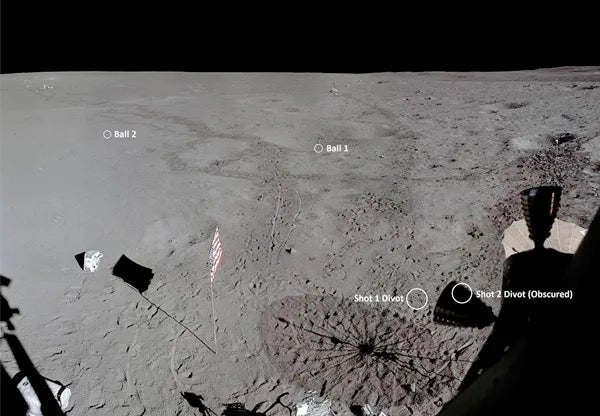
Some 50 years ago, Alan Shepard hit some golf balls on the Moon during the Apollo 14 mission. Just how far could a tour pro hit a golf ball on the Moon if they weren’t encumbered by a spacesuit?
Jim Knoll
Vancouver, Washington
Alan Shepard shanked his first shot into a crater, but estimated that his second reached a distance of about 200 yards (183 meters). However, evidence from photos taken during the mission and remastered in 2021 suggests that Shepard managed to only hit his second golf ball some 40 yards (36.5 m).
To be fair, Shepard was restricted by more than just his bulky spacesuit. His makeshift golf club wasn’t exactly regulation — just a 6-iron head attached to a collapsible tool designed to scoop lunar rocks.
An unencumbered golfer on the Moon would certainly be able to do much better. According to PGA Tour stats, pros averaged 299.9 yards (274.2 m) per drive during the just-finished 2022–2023 season. If they could replicate the same ballstriking technique on the Moon, how much farther could they drive a ball?
To calculate that, we have to dive deeper into the stats. For this past season, the average tour pro was imparting a ball speed of 172.85 mph (278.18 km/h) and launching the ball at an angle of 10.49° off the tee. Factoring in lunar gravity — roughly one-sixth that of Earth’s — the laws of projectile motion tell us that an average tour pro’s tee shot would carry about 1,440 yards (1,317 m).
The lack of air on the Moon hurts distance (a little)
Now, you may have noticed that despite the Moon having only one-sixth the gravitational pull of Earth, the distance we’ve calculated for an equivalent lunar tee shot is significantly less than six times the distance of the average tour drive, which would be roughly 1,800 yards (1,646 m]. That’s because on Earth, air helps a golf ball fly farther: a golf club imparts backspin to a ball, which allows the ball to generate aerodynamic lift and keeps it aloft. The low launch angle of a driver is the most efficient way to maximize that lift while also minimizing drag along the ball’s trajectory. So while the Moon’s reduced gravity helps a ball travel farther, perhaps counterintuitively, the lack of air on the Moon reduces that distance gain — at least when assuming that our lunar golfer is using equipment and generating launch angles and ball speeds similar to those on Earth.
In order to truly exploit the lack of air resistance on the Moon, a golfer would need to launch a ball at the ideal ballistic angle of 45° — while also maintaining ball speed. That’s trickier than simply selecting a club with more loft: A more lofted club would slide under the ball and impart more backspin, converting less of the energy of the impact into ball speed. Our golfer would probably need to find a way to anchor themselves on a lunar upslope to let a driver rip while also achieving a 45° launch angle.
But if a pro were able to do so and achieve the tour average ball speed of 172.85 mph (278.18 km/h), the ball would travel about 4,023 yards or 2.29 miles (3.69 km). The tour’s longest hitter, Rory McIlroy, with his average ball speed of 184.47 mph (296.88 km/h), could hit a lunar golf ball even farther: 4,582 yards, or 2.60 miles (4.19 km).
Mark Zastrow
Senior Editor









